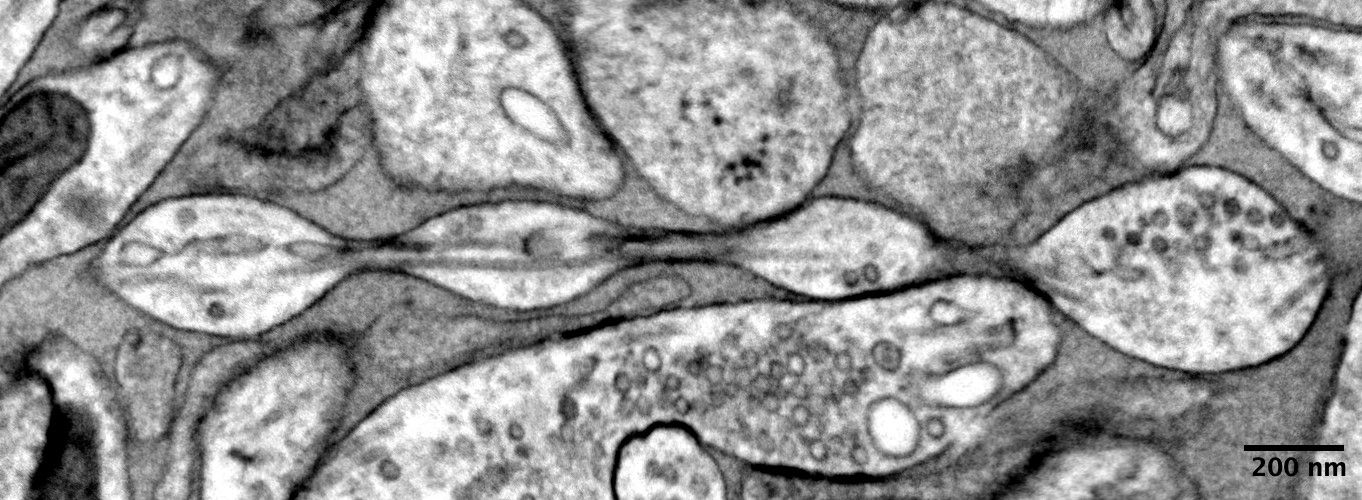A provocative study is claiming that biology textbooks are going to need some major revisions – although not everyone is convinced. The axons of a neuron – the arm-like structures that stretch out and exchange signals with other brain cells like wires – are often depicted as sausage-like cylindrical tubes, but new imaging suggests they possess a significantly different structure.
Using advanced imaging techniques, neuroscientists from the University of California, San Diego and Johns Hopkins University School of Medicine took a fresh look at the nanoscopic structure of mouse brain cells to reveal a “pearls on a string” structure.
Instead of showing a smooth cylindrical shape, the axons appeared to have a distinctive structure that featured wider, bulbous segments (the “pearls”) alternating with narrower, thread-like connections (like the “string” of a necklace).
“These findings challenge a century of understanding about axon structure,” Shigeki Watanabe, study author and associate professor of cell biology and neuroscience at the Johns Hopkins University School of Medicine, boldly proclaimed in a statement.

Micrograph image of the “pearling” structure of an axon.
Image credit: Quan Gan, Mitsuo Suga, Shigeki Watanabe
Along with challenging old assumptions, the study authors argue their observations could help to better explain how axons transmit information.
“Understanding the structure of axons is important for understanding brain cell signaling. Axons are the cables that connect our brain tissue, enabling learning, memory and other functions,” added Watanabe.
“A wider space in the axons allows ions [chemical particles] to pass through more quickly and avoid traffic jams,” he noted.
The researcher said they came across this structure by using high-pressure freezing electron microscopy, which can preserve the axons’ shape and structure.
“To see nanoscale structures with standard electron microscopy, we fix and dehydrate the tissues, but freezing them retains their shape – similar to freezing a grape rather than dehydrating it into a raisin,” explained Watanabe.
The finding isn’t totally out of the blue. Scientists have previously seen so-called “axon beading” in dying brain cells and the brains of people with neurodegenerative diseases, which has been presumed to be the result of dwindling cells losing their structural integrity.
Conversely, this new study argues that the pearled shape is, in fact, the normal state of axons – at least, those not covered by an insulating layer of myelin, which were the focus of the study. Flipping the argument, they contend that previous imaging techniques had erroneously portrayed the axons as smooth and sausagey, not bulbous and beady.
Other experts in the field are intrigued by the findings, although not wholly convinced just yet. One quibble with the study is that the new imaging technique might also be skewing the results.
“While quick freezing is an extremely rapid process, something may happen during the manipulation of the sample […] that also causes the beading,” Pietro De Camilli, a neuroscientist from the Yale School of Medicine, who was not involved in the study, told Science.
Tong Wang, a neuroscientist from ShanghaiTech University, added that the new study might simply show that “axon morphology in living animals is under constant and dynamic change.”
Despite some pushback, the study’s authors remain confident in their conclusions. To follow-up on the study, they hope to replicate the findings in human axons by analyzing brain samples from patients undergoing brain surgery and individuals who have died from neurodegenerative diseases.
The study is published in the journal Nature Neuroscience.
Source Link: We Need To Redraw The Biology Textbooks About Brain Cells, Claims A New Study